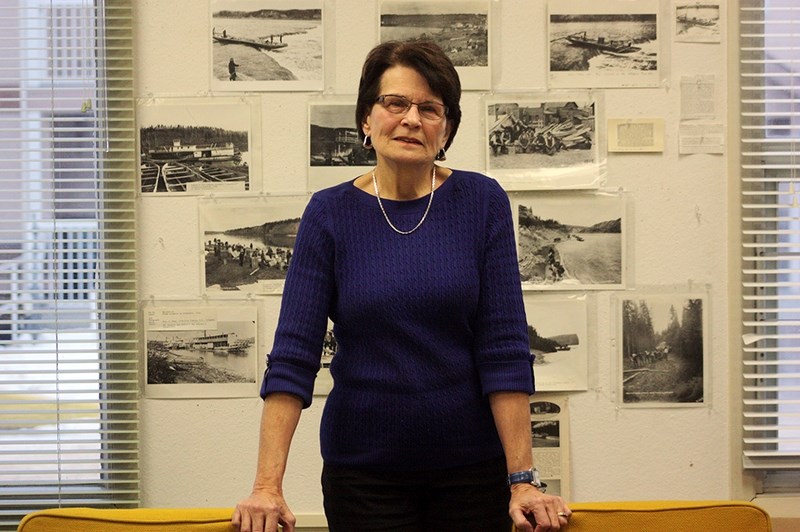Over her 25-year tenure as archivist in Athabasca, Marilyn Mol managed to help “hundreds and hundreds” of people in reuniting with lost relatives and educating area youth in local history.
Now, Mol’s legacy at the Athabasca Archives will be immortalized with a photo of her hung inside the archives Jan. 16.
Mol retired from the archives in 2016, and said as an archivist she gathered and organized historical material, helped in research projects, taught people the history of Athabasca and reunited people in search of lost relatives.
Current archivist Gina Payzant said she would place Mol’s photo alongside important figures in the history of Athabasca Archives management.
“She left the community with an understanding of the importance of archives,” Payzant said. “By leading the way as archivist and running an outstanding small-town archives, she taught the community how important archives are in our modern life.”
Working the archives
Mol said she began her work in the Athabasca Archives in 1991. It was work that suited her skills in education and library science, and as a part-time job, fit with her schedule raising three kids.
As someone originally from Saskatchewan, Mol said it was a learning experience becoming an archivist in Athabasca.
“This isn’t the community I grew up in, so I had a lot to learn,” she said. “You become more valuable over time.”
Mol helped hundreds upon hundreds of people over the course of her archivist career in Athabasca, she said. Her help on research projects and history books involving the Athabasca area also landed the Athabasca Archives several credits, she said.
“There are many books that bear Athabasca Archives name in the credits, which is nice. Books from independent researchers as well as local history books,” Mol said.
She highlighted one example of helping the Canadian Museum of History find information on Toles School in Amber Valley for a display in its Canada Hall.
“Being involved in some of those fairly large projects and having little Athabasca put on the map in that way was really very special,” Mol said.
Despite Athabasca’s relatively young history, Mol said there is plenty worth exploring about the past of the community.
“This isn’t Prague and this isn’t London and this isn’t even Quebec City. I get it,” Mol said. “This is a young town. But already there are buildings standing downtown and we don’t know who built them.”
Over her tenure, Mol said she helped teach many Grade 2 schoolchildren from Whispering Hills Primary School, who visited the archives annually in June.
“I always see these kids as I’m just looking at the future councillors for the town and county of Athabasca,” Mol said. “You just figure it out. Show them the pictures. Pictures speak louder than words.”
Under her watch, the Athabasca Archives also moved forward into the digital era. Mol said archives across the country made a united move in the mid 1990s to collect archival content online – including Athabasca.
Photos and audio recordings from the Athabasca Archives have also been digitized with people from around the world utilizing the online content, she added.
“A few people from Europe have contacted me, people from the United States,” Mol said about the impact of the digitization of archives. “That’s how they get to know.”
The long-time face of the Athabasca Archives reunited many people over her tenure, Mol said, adding it was a good part of the job.
“It’s really cool,” Mol said about the feeling of reuniting people. “I never ever was not happy to come here. If somebody came you did your best to find answers.”
Athabasca local Doris Shalapay is one of the people Mol helped connect to family members. When distant Australian relatives came to Athabasca in search of family members in the area, Mol said she was able to steer them in the right direction toward Shalapay.
Shalapay said Mol’s assistance meant a lot to her, and she was very helpful as an archivist.
“If you went there for help, she wouldn’t just help you, she would do more than help you,” Shalapay said. “Go the extra mile, just really try and help find the information you want. I just appreciated the work she did there.”
As Mol’s successor, Payzant said she was quickly challenged with people noting she had very big boots to fill.
“I immediately agree, because it’s true. Marilyn’s highly respected,” Payzant said. “She’s extremely knowledgeable.”
However, one challenge to the archives in Mol’s tenure – which is still a problem today – is the need for a new facility for the library and archives, Mol said.
She said a new facility was something she helped push for as an archivist and she remains hopeful it will come.
“I am looking forward to the day when the library and archives have a new facility, because the material in the archives can never be replaced. It’s irreplaceable,” Mol said, adding the foundations to the building are not strong. “There have been supreme efforts (to get a new facility).”
Mol said the archives remain an important resource to continue chronicling the history of Athabasca as it unfolds.
“There’s a time where everybody needs to know some information and history isn’t just from a long time ago,” Mol said. “History’s happening today. People wondering when the official opening for the Multiplex was, things like that. It’s all part of their history.”


